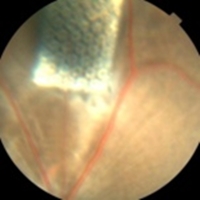Prosthetic retina offers simple solution to restoring sight
18 May 2012
 The device would be simpler in design and operation than existing models. It acts by electrically stimulating neurons in the retina, which are left relatively unscathed by the effects of AMD while other 'image capturing' cells, known as photoreceptors, are lost.
The device would be simpler in design and operation than existing models. It acts by electrically stimulating neurons in the retina, which are left relatively unscathed by the effects of AMD while other 'image capturing' cells, known as photoreceptors, are lost.It would use video goggles to deliver energy and images directly to the eye and be operated remotely via pulsed near infra-red light- unlike most prosthetic retinas, which are powered through coils that require complex surgery to be implanted.
The prosthetic retina is a thin silicon device that converts pulsed near infra-red light to electrical current that stimulates the retina and elicits visual perception. It requires no wires and would make surgical implantation simpler.
The device has been shown to produce encouraging responses in initial lab tests and is reported in an article published in Nature Photonics. The technology is now being developed further.
Dr Keith Mathieson, now a Reader in the Institute of Photonics at the University of Strathclyde in Glasgow, was one of the lead researchers and first author of the paper. He said: ''AMD is a huge medical challenge and, with an aging population, is continuing to grow. This means that innovative, practical solutions are essential if sight is to be restored to people around the world with the condition.
''The prosthetic retina we are developing has been partly inspired by cochlear implants for the ear but with a camera instead of a microphone and, where many cochlear implants have a few channels, we are designing the retina to deal with millions of light sensitive nerve cells and sensory outputs.
''The implant is thin and wireless and so is easier to implant. Since it receives information on the visual scene through an infra-red beam projected through the eye, the device can take advantage of natural eye movements that play a crucial role in visual processing.''
The research was co-authored by Dr. Jim Loudin of Stanford and led by Professor Daniel Palanker, also of Stanford, and Professor Alexander Sher, of the University of California, Santa Cruz.
Professor Palanker said, "The current implants are very bulky, and the surgery to place the intraocular wiring for receiving, processing and power is difficult. With our device, the surgeon needs only to create a small pocket beneath the retina and then slip the photovoltaic cells inside it."
Dr Mathieson was supported through a fellowship from SU2P, a venture between academic institutions in Scotland and California aimed at extracting economic impact from their joint research portfolio in photonics and related technologies.
Strathclyde leads the collaboration, which also includes Stanford, the Universities of St Andrews, Heriot-Watt and Glasgow and the California Institute of Technology. SU2P was established through funding from Research Councils UK- as part of its Science Bridges awards- the Scottish Funding Council and Scottish Enterprise.
The research links to Photonics and Health Technologies at Strathclyde- two of the principal themes of the University's Technology and Innovation Centre (TIC), a world-leading research and technology centre transforming the way universities, business, and industry collaborate.
Through Health Technologies at Strathclyde, academics work with industry and the health sector to find technologies for earlier, more accurate disease detection and better treatments, as well as life-long disease prevention.






.webp)















